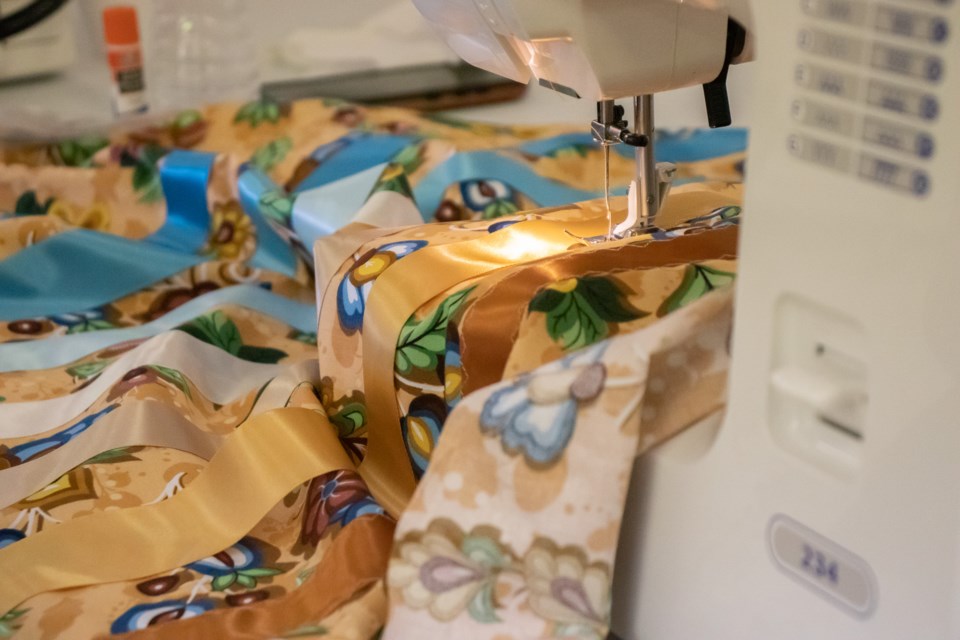SADDLE LAKE – The gentle whir of sewing machines filled a spacious room, along with the soft murmur of conversation, while colourful fabrics were turned into skirts the colour of a rainbow.
May 12-14 marked the first weekend of a free “Ribbon Skirt Making Classes with Cree Language Teachings,” an initiative where participants immerse themselves in the essence of cultural preservation, reconciliation, inclusion, and unity. The first set of classes were held in Saddle Lake.
Funded by Heritage Canada, and led by the Acimowin Opaspiw Society (AOS), the program aims to bridge cultural gaps and foster reconciliation, says Leah Redcrow, research lead and executive director of the society.
“Anyone can sign up,” says Redcrow, explaining that while the first classes in Saddle Lake were mostly aimed at members of the Saddle Lake community, classes were also scheduled for St. Paul and Edmonton. From May 19-21, classes were held in St. Paul, for example.
And there will be plenty more chances to take part, with classes set to take place five times in each location until March 31, 2024. Classes are free for participants, including the supplies, use of sewing machines, and meals.
Redcrow explains this approach is to accommodate Indigenous people living off-reserve, but also so non-Indigenous people in the surrounding communities can participate.
“I think that’s really important, in that I’m hoping what comes from that is [people] learning from each other,” which is a big step toward reconciliation, Redcrow explains. Reconciliation is about inclusion and understanding one another’s cultures, she adds.
Teaching how to sew ribbon skirts involves learning something new, while also learning what the ribbon skirt represents in the Indigenous culture, along with the 'why' and 'when' ribbon skirts are worn. The class also teaches participants how to individualize the skirt “to tell your own story.”
Sewing and language
Beverly Pasquayak, facilitator of the ribbon skirt initiative, is a skilled seamstress and regalia-maker in the Saddle Lake community. Pasquayak is sharing her knowledge, teaching others how to sew ribbon skirts.
Sewing ribbon skirts is tied deeply to Indigenous culture, says Pasquayak, and each individual has their own unique “choice of colours... preferences.” People are encouraged to incorporate those unique preferences into their skirt.
She explains that a lot of the time, ribbon skirts are used in ceremonies, but many people also wear them “because they feel good” wearing them. “They feel pride.”
Pasquayak credits many of her skills to her mother – Emilia Pasquayak – who she says has a gift for sewing.
This gift, according to Emilia, is a “gift from the Creator... the higher power,” which she passes down to the younger generations. As someone who went to residential school in Blue Quills, sewing has been a way of healing for Emilia.
She started sewing by hand when she was in her 30s, while she was battling cancer, and it helped with her healing. From then on, she started making star blankets and powwow regalia.
“Sewing is a healing therapy,” she says, recommending others try it out as well.
In addition to ribbon skirt sewing, teaching about the Cree language is also tied to the initiative, this portion taught by Irene Cardinal.
Cardinal says many of the Cree words she teaches are tied to sewing, but she also teaches “how to greet” and introduce yourself to others. Outside of the initiative, Cardinal also has a background in teaching conversational Cree in a formal setting to non-Indigenous and Indigenous people.
“It’s a real, beautiful language,” she says. Cardinal likes to use humour when teaching, which students often appreciate. She believes that while non-Indigenous people do not necessarily have to learn how to speak the language, understanding the language helps in understanding “where we’re coming from, where we’re going, and where we’re at.”
Healing
Trina Shirt was among the participants at the May 13 class. She felt emotional when speaking about the Indigenous language.
“I’m thankful that we still have our identities... and our language stayed alive,” following the trauma Indigenous people went through, such as residential schools.
When speaking about residential schools and its effects on Indigenous peoples, Shirt believes that simply coming together and talking is raising awareness, in addition to helping with “healing our spirit."
Redcrow is looking forward to future classes and sharing the Indigenous culture. She hopes Indigenous and non-Indigenous people alike sign up and learn from one another.
“I think that’s a good path forward.”



